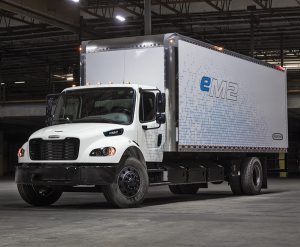
CARB’s Innovative Clean Transit regulation requires that public transit agencies transition to zero-emission bus fleets. Photo courtesy Gillig.
The steady deep throb of a diesel engine is not as menacing as a villain’s laugh, but it is a threat nevertheless. Diesel exhaust is full of tiny sooty particles made up of black carbon, toxic air contaminants, and other unhealthy components such as heavy metals. It is bad for the global climate as a whole, and also for the human bodies that encounter it. It is also a daily companion for many in the Bay Area.
From construction equipment, to trucks waiting outside ports, to backup power generators behind neighborhood supermarkets, diesel engines are everywhere. They are especially prevalent in low-income, mixed-zoning neighborhoods where residences share fence lines with commercial, light industrial, and even heavy industrial activities.
Diesel engines are so ubiquitous because, unlike gasoline, diesel contains lubricants which make diesel engines reliable and long-lasting. The fuel is readily available, since it is a companion product to jet fuel, and diesel engines are more fuel-efficient than gasoline engines. They are unusual in American passenger vehicles, other than some pickups, but they are the standard for heavy-duty uses — trucks, locomotives, construction equipment, port and airport vehicles, and backup generators.
Diesel exhaust is a multi-level threat. It contributes about 25 percent of the Bay Area’s black carbon, which heats the atmosphere by absorbing sunlight. It contains fine particulates that irritate the body, causing inflammation, lung damage, heart disease, and dementia. Diesel particulates carry the greatest cancer risk of all air pollutants.
Numerous studies have shown that impacts are greatest in neighborhoods with low incomes and high percentages of people of color; physical effects of diesel pollution are amplified by other factors contributing to health disparities, but an underlying problem is the greater number of diesel sources in these communities.
New studies are indicating that other areas are also at risk. Between January 2018 and February 2019, the California Office of Environmental Health Hazard Assessment did an intensive study of 40 households in the East Bay between San Leandro and Hercules, examining one child and one adult in each household. The families varied in their ethnicity and lifestyles, but the study found that chemicals from diesel exhaust were detected in all 40 children, 39 of 40 adults, and in air and dust samples from the homes, sometimes at high levels.
In 2018, in conjunction with the International Climate Action Summit held in San Francisco, the Bay Area Air Quality Management District launched its Diesel Free by ’33 challenge. The agency asked leaders across the region to sign a statement of purpose to eliminate diesel use in their communities by the end of 2033. To support signatories and raise general awareness, the Air District hosted a recent series of Diesel Free by ’33 webinars covering health risks, the availability of alternatives, and funding options for the transition.
There are numerous types of diesel engines, meaning that many different categories of replacements need to be designed, tested, and adopted. Buses and heavy-duty trucks, which are familiar sources of diesel exhaust, have been early targets for diesel emissions reductions. Strategies for achieving these reductions include relying on natural gas, hydrogen fuel cells, and renewable diesel. Public transit agencies are now pursuing zero-emission technologies to comply with the state’s Innovative Clean Transit regulation; adopted in 2018, it requires them to gradually transition to a 100-percent zero-emission bus fleet.
Trucks have also been the target of increasingly stringent requirements, most recently the California Air Resources Board’s Advanced Clean Trucks regulation. Approved in June, it will force a steady increase in the percentage of zero-emission medium- and heavy-duty vehicles sold in California by 2035.

CARB’s Advanced Clean Trucks regulation is promoting the use of zero-emission medium- and heavy-duty vehicles. Photo courtesy Freightliner.
According to the Air District’s Adam Shapiro, “Moving to zero-emission has a short payback period for trucking, even without CARB credits, due to lower fuel and maintenance costs.” Infrastructure for charging or hydrogen fueling is the largest investment, but there are incentives available for transitioning to cleaner technology.
Cleaner off-road construction equipment, including tower cranes and concrete mixers, is also commercially available. The Port of Oakland is already using non-diesel alternatives for cargo handling equipment. Amy Dao, Shapiro’s colleague in the Air District’s Strategic Incentives Division, informed webinar participants that airport ground support equipment is readily adaptable to electric vehicles because of short trips and proximity to charging infrastructure.
Additional types of off-road construction equipment, cargo handlers, locomotives, and harbor craft are being tried out. The Air District is a financial partner in a new ferry powered by hydrogen fuel cells. John Deere has been testing zero-emission tractors for agriculture since 2016. Replacements for some categories of diesel engines, including various types of marine vessels, are still in the research stage, but Dao remarked, “There are lots of reasons to be hopeful. Just having pilot demonstrations happening is a really great sign.” She noted there are “multiple manufacturers internationally working on these options.” Several Air District webinars covered the multiple sources of financial assistance for pilot programs, infrastructure, and equipment.
Next to buses and various types of trucks, back-up generators represent the most widely spread use of diesel throughout the region. While these generators are intended to provide electricity during power outages, they are run monthly for testing as well as in emergencies. During recent power shortages, the Air District allowed backup generators to run more than usually permitted, to relieve the grid.
“Disadvantaged communities are clustered around commercial and industrial locations, many of which use backup generators,” CARB Air Pollution Specialist Pippin Mader told the Monitor. “Diesel backup generators, in particular, affect the people right next door. Testing them monthly means there are exposures happening monthly.” In his webinar presentation, he mentioned that testing a diesel generator monthly is dirtier than a fuel-cell alternative running 24 hours a day, seven days a week.
Because diesel engines are so durable, Mader emphasized that “they will be functional for a very long time.” Retrofitting diesel backup generators may be an option in some cases, but older ones generally can’t be retrofitted. Mader noted that although there are effective particulate filters for diesel generators, and they are required for newer generators, “the best filters are not always the filters that are being used, and some existing generators have none at all.”
There are non-diesel generators in use, although they may need to be customized for special situations. Many burn natural gas or propane; these are not zero-emission, but they are better for air quality, if not for greenhouse gases. However, the mantra for CARB is to look at zero-emission options first, “and there are technologies on the horizon,” according to Mader. There is also funding, including PG&E’s Self Generation Incentive Program, which is currently focused on serving vulnerable customers in state-defined “resiliency zones” facing power shutoffs, high fire danger, or both. The program offers additional incentives in disadvantaged communities.
Cities which signed the Diesel Free by ’33 statement of purpose are beginning to adopt some of the technologies and planning to adopt more. In Windsor, “the Town has replaced a diesel-fueled dump truck with a gasoline model, and plans on replacing all diesel standard service vehicles with gasoline vehicles when they reach the end of their service life,” environmental program manager Veronica Siwy wrote in an email. “We are also working toward ensuring that all heavy equipment that does still use diesel (generators, for example) are CARB compliant.” Oakland recently began to use renewable diesel in all city-owned diesel equipment. The diesel is manufactured from locally-collected waste grease by a company which also supplies renewable diesel to several other Bay Area cities and agencies. Oakland is currently working on a zero-emission vehicle plan.
Oakland considers renewable diesel as a win-win, diverting waste and replacing fossil fuels, but also as a transition toward zero-emission. Renewable diesel, and its relative, biodiesel, are fuel for combustion engines, and as Air District Health Officer Judith Cutino cautioned in a webinar, combustion still generates particulates. Like CARB, the Air District emphasizes zero-emission technology and prioritizes new equipment over retrofits.
Progress toward becoming diesel-free in 2033 will involve technical advances, marketplace competition, funding, community pressure through programs like the Assembly Bill 617 (C. Garcia) planning process, and ultimately some additional regulations. The Air District’s Monte DiPalma, a senior air quality engineer who coordinated the Diesel Free by ’33 webinar series, summed it up: “In California, we try to incentivize the people that want to be at the forefront and let them figure out what works or doesn’t, then follow up with regulation.”
Leslie Stewart covers air quality and energy for the Monitor.

